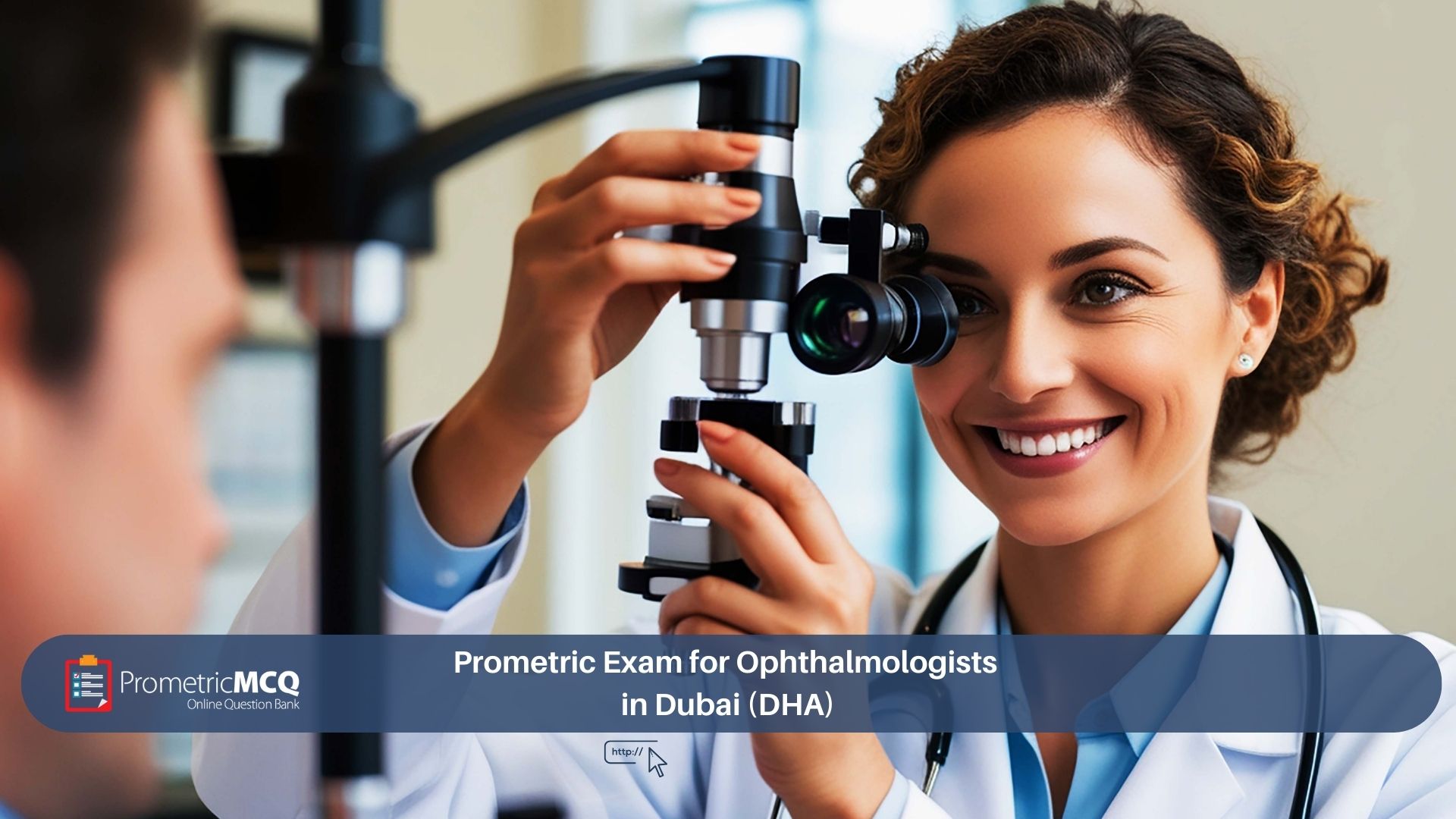
Prometric Exam for Ophthalmologists in Dubai (DHA)
fatima@prometricmcq.com2025-09-30T01:19:59+00:00Table of Contents
TogglePrometric Exam for Ophthalmologists in Dubai (DHA) – 2025 Guide
Dubai’s healthcare landscape is synonymous with innovation and excellence, making it a highly attractive destination for specialist physicians, particularly in technologically advanced fields like Ophthalmology. The opportunity to work with state-of-the-art diagnostic and surgical equipment is a major draw. However, to practice in this elite environment, every ophthalmologist must first pass the Dubai Health Authority (DHA) Specialist Exam. This is a rigorous, Prometric-administered test designed to ensure that specialists meet a world-class standard of care and clinical knowledge.
The DHA exam for Ophthalmologists is a far cry from a general medical test. It is a highly specialized, case-based examination that delves deep into the subspecialties of ophthalmology. The Multiple-Choice Questions (MCQs) are designed to test your ability to interpret complex diagnostic imaging (like OCT and fluorescein angiography), formulate evidence-based treatment plans for conditions ranging from diabetic retinopathy to complex glaucoma, and manage surgical complications. Success requires a profound, guideline-driven understanding of the entire field.
This ultimate 2025 guide is your comprehensive blueprint for conquering the DHA Ophthalmology exam. We will provide a meticulous breakdown of the exam’s pattern, a deep dive into the high-yield syllabus topics, and a series of challenging, exam-style questions with detailed, guideline-based rationales. To eliminate any uncertainty, a robust 10-point FAQ section will address the key questions and concerns for ophthalmology specialists. This is your definitive resource for passing the exam and securing your license to practice in Dubai.
Key Takeaways for the DHA Ophthalmology Exam
- Retina is the Highest Yield: A very large portion of the exam is dedicated to medical and surgical retina. Master diabetic retinopathy, ARMD, and retinal detachments.
- Master Diagnostic Interpretation: Proficiency in interpreting OCT, fluorescein angiography (FA), and visual fields is absolutely essential.
- Guideline-Driven Answers are a Must: Your choices must align with the latest international, evidence-based guidelines from bodies like the American Academy of Ophthalmology (AAO).
- Know Your Optics and Refraction: Do not neglect the basics. Expect challenging questions on optics, refraction, and IOL calculations.
- Specialty-Specific MCQs are Crucial: Your success depends on intensive practice with a high-quality QBank tailored specifically to ophthalmology.
Deconstructing the DHA Ophthalmology Exam: Pattern and Syllabus
A successful study strategy begins with a clear understanding of the exam’s architecture. While administered by Prometric, the content is curated by the DHA to test for specialist-level competency. This knowledge is a key part of your overall DHA Prometric exam preparation.
Core Exam Framework
- Administrator: Prometric
- Format: Computer-Based Test (CBT) with 100% MCQs.
- Structure: Typically 150 MCQs.
- Duration: 2.5 hours (150 minutes).
- Scoring: A Pass/Fail result is given. The unofficial passing score for specialist exams is high, estimated to be in the 65-70% range. There is no negative marking.
High-Yield Syllabus Breakdown
The exam covers the entire breadth of ophthalmology. A strategic preparation plan focuses on these key domains.
| Ophthalmology Domain | High-Yield Topics and Key Concepts for 2025 |
|---|---|
| Retina and Vitreous (~30-35%) | This is the most heavily tested domain. Diabetic Retinopathy: Classification (ETDRS), management of diabetic macular edema (anti-VEGF vs. laser), indications for vitrectomy. Age-Related Macular Degeneration (ARMD): Differentiating wet vs. dry, treatment with anti-VEGF agents. Other: Retinal detachment (types and management), retinal vein and artery occlusions, and interpretation of OCT and Fluorescein Angiography (FA). |
| Glaucoma (~15-20%) | Diagnosis and management of primary open-angle glaucoma (POAG) and primary angle-closure glaucoma (PACG). Interpretation of visual fields (Humphrey), gonioscopy, and OCT of the optic nerve head. Medical, laser (SLT, LPI), and surgical management options. |
| Cornea and External Disease (~15-20%) | Differential diagnosis of the red eye. Management of infectious keratitis (bacterial, viral, fungal). Corneal dystrophies and degenerations. Principles of dry eye management and basics of corneal transplantation. |
| Cataract and Refractive Surgery (~10-15%) | Pre-operative assessment of cataract patients, biometry and IOL power calculation formulas (e.g., SRK/T). Management of intraoperative and postoperative complications (e.g., posterior capsular rupture, endophthalmitis). Basics of LASIK and PRK. |
| Pediatric Ophthalmology & Strabismus (~10%) | Diagnosis and management of amblyopia and strabismus. Evaluation of leukocoria (retinoblastoma vs. others). Management of congenital cataracts and congenital glaucoma. Retinopathy of prematurity (ROP) screening and classification. |
| Neuro-ophthalmology, Uveitis, & Optics (~5-10%) | Optic neuropathies (e.g., optic neuritis, AION). Papilledema. Cranial nerve palsies affecting ocular motility. Workup of uveitis. Refraction, optics of the eye, and basic ophthalmic instrumentation. |
High-Yield Ophthalmology MCQs: Free Practice Questions
The following questions are designed to simulate the advanced clinical reasoning tested on the DHA exam. Analyze each case and its detailed rationale. For comprehensive preparation, a dedicated QBank of Ophthalmology MCQs is your most critical study tool.
Question 1: Retina
A 58-year-old patient with poorly controlled type 2 diabetes presents for an annual eye exam. Fundoscopy reveals numerous microaneurysms, dot-blot hemorrhages, hard exudates, and cotton wool spots in all four quadrants of the right eye, along with venous beading in two quadrants. There is no evidence of neovascularization. According to the ETDRS classification, what is the stage of diabetic retinopathy, and what is the most critical next step?
- Mild NPDR; schedule a follow-up in one year.
- Moderate NPDR; schedule a follow-up in 6 months.
- Severe NPDR; refer for pan-retinal photocoagulation (PRP) urgently.
- Proliferative DR; administer an intravitreal anti-VEGF injection.
Correct Answer: C (Severe NPDR; refer for pan-retinal photocoagulation (PRP) urgently.)
Rationale: This question tests your knowledge of the diabetic retinopathy classification and management guidelines. The findings described fit the “4-2-1 rule” for Severe Non-Proliferative Diabetic Retinopathy (NPDR): severe hemorrhages/microaneurysms in 4 quadrants, venous beading in 2 quadrants, or IRMA in 1 quadrant. This patient meets two of these criteria. Severe NPDR carries a very high risk of progressing to high-risk Proliferative Diabetic Retinopathy (PDR) within a year. Therefore, the standard of care, based on landmark trials, is to consider prompt pan-retinal photocoagulation (PRP) to reduce the risk of vision-threatening neovascularization.
Why other options are incorrect:
A & B: The findings are far more advanced than mild or moderate NPDR. Simply following up would be substandard care given the high risk of progression.
D: The description explicitly states there is no neovascularization, so the diagnosis is not yet Proliferative DR. Anti-VEGF is primarily used for diabetic macular edema or PDR, not for severe NPDR without edema.
Question 2: Glaucoma
A 65-year-old woman presents to the emergency department with a 3-hour history of severe right eye pain, blurred vision, seeing halos around lights, and nausea. On examination, the eye is red, the cornea is hazy, and the pupil is mid-dilated and non-reactive. Intraocular pressure (IOP) is 55 mmHg. What is the most appropriate initial medical management?
- Start oral acetazolamide, topical beta-blockers, and topical alpha-agonists.
- Instill a cycloplegic agent like atropine to relieve pain.
- Perform an immediate laser peripheral iridotomy (LPI).
- Administer intravenous mannitol and refer for emergency cataract surgery.
Correct Answer: A
Rationale: This is a classic presentation of acute primary angle-closure (APAC), an ophthalmic emergency. The immediate goal of medical management is to lower the extremely high IOP to prevent optic nerve damage and clear the cornea. This is achieved with a multi-pronged medical attack: 1) An aqueous suppressant to reduce fluid production (e.g., oral acetazolamide, a carbonic anhydrase inhibitor, and a topical beta-blocker like timolol). 2) A drug to increase uveoscleral outflow (e.g., a topical alpha-agonist like apraclonidine). A miotic agent like pilocarpine is also often used, but only after the IOP starts to lower, as it may not work on an ischemic iris sphincter.
Why other options are incorrect:
B: A cycloplegic agent would worsen the pupillary block and is contraindicated.
C: LPI is the definitive treatment to relieve pupillary block, but it cannot be performed until the cornea is clear and the inflammation has subsided. It is not the initial step.
D: IV mannitol is a second-line agent if initial medical therapy fails. Cataract surgery is a definitive treatment but not the immediate emergency management.
Frequently Asked Questions (FAQs) for the DHA Ophthalmology Exam
The result is Pass/Fail, with no numerical score provided. The unofficial passing threshold for a highly specialized exam like ophthalmology is estimated to be in the 65% to 70% range.
Your foundation should be the *Basic and Clinical Science Course (BCSC)* series from the American Academy of Ophthalmology (AAO). This should be supplemented with a high-quality, board-review style question bank that focuses on clinical vignettes and image interpretation.
Do not neglect the basics. While it’s a smaller portion of the exam than retina or glaucoma, there will be several challenging conceptual questions on optics, refraction, and IOL calculations. You must have a solid understanding of these principles.
It is absolutely critical. A significant number of questions will be based on images. You must be able to confidently interpret fundus photos, fluorescein angiograms, OCT scans of the retina and optic nerve, and Humphrey visual fields.
Primary Source Verification (PSV) by DataFlow is a mandatory verification of your medical degree, ophthalmology residency/fellowship certificates, board certifications, and professional experience. A positive DataFlow report is required by the DHA before your final DHA license can be issued.
You won’t be asked to detail every step of a phacoemulsification or vitrectomy. However, you are expected to know the indications for procedures, the key principles, and, most importantly, the recognition and management of common intraoperative and postoperative complications.
The Consultant exam assumes a higher level of expertise and leadership. It will likely feature more questions on managing the most complex and refractory cases, revision surgeries, interpreting cutting-edge research, and may include aspects of clinical governance and teaching.
Candidates are generally allowed three attempts to pass. A waiting period is required between attempts. A failure should prompt a thorough reassessment of your preparation strategy, with a greater focus on guideline-based medicine and intensive MCQ practice.
No, the exam is based on international standards and evidence-based medicine. Your preparation should be centered on guidelines from major international bodies like the AAO, not local protocols.
Two common reasons are: 1) Underestimating the breadth of the exam and focusing too much on one’s own subspecialty while neglecting others. 2) Insufficient practice with high-quality, image-based MCQs, leading to poor test-taking strategy and time management.
Conclusion: Your Vision for a Career in Dubai
The DHA exam for Ophthalmologists is a rigorous and demanding test, designed to certify a high level of specialist competence and ensure the safety and well-being of patients in Dubai. It is a challenge that rewards a deep, evidence-based understanding of the entire field, from the retina to the cornea. By structuring your preparation around the latest clinical guidelines, mastering the interpretation of key diagnostics, and dedicating yourself to intensive practice with high-quality MCQs, you can confidently meet this challenge. Passing this exam is the definitive step toward a successful and rewarding career as an ophthalmologist in the UAE’s vibrant and advanced healthcare ecosystem.
Ready to Focus Your Preparation and Ace the Exam?
Our comprehensive Ophthalmology MCQ package is filled with high-yield, guideline-based clinical cases, detailed rationales, and high-resolution images to cover the entire DHA syllabus and ensure your success.










